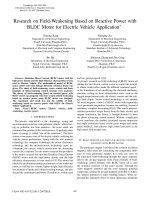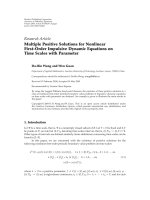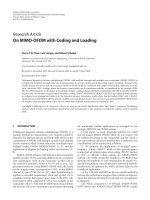Perspectives on HCI research with teenagers
Bạn đang xem bản rút gọn của tài liệu. Xem và tải ngay bản đầy đủ của tài liệu tại đây (6.54 MB, 284 trang )
Human–Computer Interaction Series
Linda Little
Daniel Fitton
Beth T. Bell
Nicola Toth Editors
Perspectives on
HCI Research
with Teenagers
Human–Computer Interaction Series
Editors-in-chief
Desney Tan, Microsoft Research, USA
Jean Vanderdonckt, Université Catholique de Louvain, Belgium
HCI is a multidisciplinary field focused on human aspects of the development of
computer technology. As computer-based technology becomes increasingly
pervasive – not just in developed countries, but worldwide – the need to take a
human-centered approach in the design and development of this technology
becomes ever more important. For roughly 30 years now, researchers and
practitioners in computational and behavioral sciences have worked to identify
theory and practice that influences the direction of these technologies, and this
diverse work makes up the field of human-computer interaction. Broadly speaking
it includes the study of what technology might be able to do for people and how
people might interact with the technology. The HCI series publishes books that
advance the science and technology of developing systems which are both effective
and satisfying for people in a wide variety of contexts. Titles focus on theoretical
perspectives (such as formal approaches drawn from a variety of behavioral
sciences), practical approaches (such as the techniques for effectively integrating
user needs in system development), and social issues (such as the determinants of
utility, usability and acceptability).
Titles published within the Human–Computer Interaction Series are included in
Thomson Reuters’ Book Citation Index, The DBLP Computer Science Bibliography
and The HCI Bibliography.
More information about this series at />
Linda Little • Daniel Fitton
Beth T. Bell • Nicola Toth
Editors
Perspectives on HCI
Research with Teenagers
Editors
Linda Little
PaCT Lab, Department of Psychology,
Faculty of Health and Life Sciences
Northumbria University
Newcastle, UK
Beth T. Bell
Faculty of Health and Life Sciences
York St John University
York, UK
Daniel Fitton
Child-Computer Interaction Group,
School of Physical Sciences
and Computing
University of Central Lancashire
Preston, UK
Nicola Toth
PaCT Lab, Department of Psychology,
Faculty of Health and Life Sciences
Northumbria University
Newcastle, UK
ISSN 1571-5035
Human–Computer Interaction Series
ISBN 978-3-319-33448-6
ISBN 978-3-319-33450-9
DOI 10.1007/978-3-319-33450-9
(eBook)
Library of Congress Control Number: 2016947431
© Springer International Publishing Switzerland 2016
This work is subject to copyright. All rights are reserved by the Publisher, whether the whole or part of
the material is concerned, specifically the rights of translation, reprinting, reuse of illustrations, recitation,
broadcasting, reproduction on microfilms or in any other physical way, and transmission or information
storage and retrieval, electronic adaptation, computer software, or by similar or dissimilar methodology
now known or hereafter developed.
The use of general descriptive names, registered names, trademarks, service marks, etc. in this publication
does not imply, even in the absence of a specific statement, that such names are exempt from the relevant
protective laws and regulations and therefore free for general use.
The publisher, the authors and the editors are safe to assume that the advice and information in this book
are believed to be true and accurate at the date of publication. Neither the publisher nor the authors or the
editors give a warranty, express or implied, with respect to the material contained herein or for any errors
or omissions that may have been made.
Printed on acid-free paper
This Springer imprint is published by Springer Nature
The registered company is Springer International Publishing AG Switzerland
Preface
The premise for this book emerged from a 2011 EPSRC grant ‘Taking on the
Teenagers (TAKEEN)’ under the Transforming Energy Demand Through Digital
Innovation (TEDDI) scheme. The grant was led by Professor Janet C. Read, director
of the Child-Computer Interaction (ChiCI) research group at the University of
Central Lancashire (UCLan), in collaboration with four other UK universities:
Northumbria, Birmingham, Swansea and the Knowledge Lab, London. ‘TAKEEN’
was the first energy research project to engage directly with teenagers and involve
them as ‘co-investigators’. As teenagers acted as both participants and coinvestigators, this made the project unique as it educated, informed and empowered
teenagers through their active involvement. However, when designing studies for
the TAKEEN project, the research teams at Northumbria and UCLan found a distinct gap in the literature with regard to methods and approaches that best suit teenage populations.
Understanding teenagers and developing appropriate methods are key to conducting successful HCI research. Working with teenagers typically presents more
challenges than working with adults. Teenagers inhabit a diverse and changeable
world that is often unfamiliar to adults. Teenagers are also subject to change through
the biological, psychological and physical developments that occur during adolescence. Therefore it is vitally important that researchers understand teenagers’ needs
and preferences when creating new technologies and products with, and for, them.
We need to consider that adults and children have received significant specific attention within the HCI community, whilst teenagers (or adolescents) have to date
received comparatively little.
The lack of literature pertaining to appropriate methods was also reflected by the
broader HCI community in international workshops held at CHI (2012, 2013, 2014)
and IDC (2013). The overall aim of this book is to contribute to the methods and
understandings necessary to successfully and sensitively engage teenagers in HCI
research by providing (i) examples of robust methods all of the contributors have
used when working with teenagers in research and design projects and (ii) a com-
v
vi
Preface
prehensive reference book describing in detail methods, approaches and examples
of how these can been applied to HCI research and teaching.
Finally, thanks are given to the teenagers that participated and to their families
and teachers who facilitated the work.
Newcastle, UK
Preston, UK
York, UK
Newcastle, UK
March, 2016
Linda Little
Daniel Fitton
Beth T. Bell
Nicola Toth
Acknowledgement
The editors would like to thank everyone in the TAKEEN research teams based at
Northumbria and University of Central Lancashire, UK. The editors would also like
to thank all the contributing authors for all their hard work in making this book
possible.
The idea for this book emerged from a project funded by the Research Councils
UK’s Digital Economy and Energy Programmes EP/I002251/1 and EP/I000720/1.
vii
Contents
1
Introduction: HCI Reaches Adolescence ..............................................
Daniel Fitton, Linda Little, and Beth T. Bell
1
2
Understanding Adolescents ....................................................................
Beth T. Bell
11
3
Ethical Considerations in Face-to-Face and InternetMediated Research with Teenage Populations .....................................
Kerry McKellar and Nicola Toth
4
Human Factors Multi-technique Approach to Teenage
Engagement in Digital Technologies Health Research ........................
Alexandra R. Lang, Michael P. Craven, Sarah Atkinson,
Lucy Simons, Sue Cobb, and Marco Mazzola
29
61
5
Designing Interactive Technologies with Teenagers
in a Hospital Setting ................................................................................ 103
Maja van der Velden, Margaret Machniak Sommervold,
Alma Culén, and Britt Nakstad
6
Using a Rich Pictures Approach for Gathering Students
and Teachers Digital Education Requirements .................................... 133
Steve Love, Voula Gkatzidou, and Antonello Conti
7
Engaging Teens in Dialogue on Potential Technological
Futures with User Enactments............................................................... 151
William Odom, John Zimmerman, and Jodi Forlizzi
8
Involving Teenagers Today in the Design
of Tomorrow’s Technology ..................................................................... 179
Christopher R. Wilkinson
9
Designing Teenage Emotions with a Life of Their Own ...................... 207
Neil Winterburn, Peggy Gregory, and Daniel Fitton
ix
x
Contents
10
Working with Teenagers in HCI Research:
A Reflection on Techniques Used in the Taking
on the Teenagers Project ........................................................................ 237
Daniel Fitton, Beth T. Bell, Linda Little, Matthew Horton,
Janet C. Read, Michelle Rouse, and Nicola Toth
11
Future Directions for Quality TeenCI Research .................................. 269
Janet C. Read and Matthew Horton
Contributors
Sarah Atkinson Human Factors Research Group, University of Nottingham,
Nottingham, UK
Beth T. Bell Faculty of Health and Life Sciences, York St John University, York,
UK
Sue Cobb Human Factors Research Group, University of Nottingham, Nottingham,
UK
Antonello Conti Digitaria International SA, Luxembourg, Luxembourg
Michael P. Craven NIHR MindTech Healthcare Technology Co-operative,
Institute of Mental Health, University of Nottingham, Nottingham, UK
Alma Culén Department of Informatics, University of Oslo, Oslo, Norway
Daniel Fitton Child-Computer Interaction Group, School of Physical Sciences
and Computing, University of Central Lancashire, Preston, UK
Jodi Forlizzi Human-Computer Interaction Institute, Carnegie Mellon University,
Pittsburgh, PA, USA
Voula Gkatzidou Department of Design, Brunel University, Uxbridge, UK
Peggy Gregory School of Physical Sciences and Computing, University of Central
Lancashire, Preston, UK
Matthew Horton Child-Computer Interaction Group, School of Physical Sciences
and Computing, University of Central Lancashire, Preston, UK
Alexandra R. Lang Human Factors Research Group, University of Nottingham,
Nottingham, UK
Linda Little PaCT Lab, Department of Psychology, Faculty of Health and Life
Sciences, Northumbria University, Newcastle, UK
Steve Love Digital Design Studio, The Glasgow School of Art, Glasgow, UK
xi
xii
Contributors
Marco Mazzola Politecnico di Milano, Design Department, Milan, Italy
Neosperience Spa, Milan, Italy
Kerry McKellar Psychology and Communication Technology (PaCT) Lab,
Department of Psychology, Faculty of Health and Life Sciences, Northumbria
University, Newcastle, UK
Britt Nakstad Department of Pediatrics and Adolescent Medicine, Akershus
University Hospital, Lørenskog, Norway
Institute for Clinical Medicine, University of Oslo, Oslo, Norway
William Odom School of Interactive Arts and Technology, Simon Fraser
University, Surrey, BC, Canada
Janet C. Read Child-Computer Interaction Group, School of Physical Sciences
and Computing, University of Central Lancashire, Preston, UK
Michelle Rouse Macmillan Cancer Support, London, UK
Lucy Simons NIHR MindTech Healthcare Technology Co-operative, Institute of
Mental Health, University of Nottingham, Nottingham, UK
Margaret Machniak Sommervold Department of Informatics, University of
Oslo, Oslo, Norway
Nicola Toth PaCT Lab, Department of Psychology, Faculty of Health and Life
Sciences, Northumbria University, Newcastle, UK
Maja van der Velden Department of Informatics, University of Oslo, Oslo,
Norway
Christopher R. Wilkinson University of Cambridge Research Office, Cambridge,
UK
Neil Winterburn Child-Computer Interaction Group, University of Central
Lancashire, Preston, UK
John Zimmerman Human-Computer Interaction Institute, Carnegie Mellon
University, Pittsburgh, PA, USA
Chapter 1
Introduction: HCI Reaches Adolescence
Daniel Fitton, Linda Little, and Beth T. Bell
Abstract Adults have long been considered in detail in the Human Computer
Interaction (HCI) community and children within the Child-Computer Interaction
(CCI) community. However, teenagers (adolescents) have received far less specific
consideration within the HCI and CCI areas (Fitton and Bell 2014; Fitton et al.
2013a). Teenagers are possibility the most diverse, dynamic, exciting, and
technologically-aware user groups that will soon become be the next generation of
adults. Working with teenagers can enable researchers to gather valuable insights
and opportunities to inform the creation of new technologies. Researchers have now
begun to explore this new and emerging area of Teen-Computer Interaction (TeenCI)
and this book brings together some of the best work in this field to-date. The book
provides the HCI and CCI communities with an inclusive account of methods and
examples of best practise to inform those working with teenagers in technology
contexts. The chapters recount research with teenagers in many different domains
and provide many different contributions to the field of TeenCI including design
methods, models, case studies and ethical consideration important for working with
this user group. The aim of this book is to provide a solid foundation from which the
TeenCI research area can grow alongside providing a valuable resource for those
wishing to conduct HCI research with teenagers.
D. Fitton (*)
Child-Computer Interaction Group, School of Physical Sciences and Computing,
University of Central Lancashire, PR1 2HE, Preston, UK
e-mail:
L. Little
PaCT Lab, Department of Psychology, Faculty of Health and Life Sciences,
Northumbria University, Newcastle NE1 8ST, UK
B.T. Bell
Faculty of Health and Life Sciences, York St John University, York YO31 7EX, UK
© Springer International Publishing Switzerland 2016
L. Little et al. (eds.), Perspectives on HCI Research with Teenagers,
Human–Computer Interaction Series, DOI 10.1007/978-3-319-33450-9_1
1
2
1.1
D. Fitton et al.
Human Computer Interaction
Human-Computer Interaction (HCI) has one of the largest and most diverse research
communities in the world today. HCI is defined as a ‘discipline concerned with the
design, evaluation and implementation of interactive computing systems for human
use and with the study of major phenomena surrounding them’ (Hewett et al. 1992).
The discipline spans across many areas; including Computer Science, Design,
Psychology, Ergonomics, Art, Architecture, Sociology, and Music, to name just a
few. The need to understand HCI became clear after many serious and sometimes
fatal incidents involving computer-based systems (Leveson and Turner 1993). These
incidents highlighted the fact that users of systems, user interfaces and associated
usage had received frighteningly little consideration by those that created them.
While significant research on important HCI topics had been taking place since
the 1960s, it was in 1983 with the formation of ACM SIGCHI (Special Interest
Group on Computer-Human Interaction) when the HCI community we know today
began to form. This new area sought to bring together academics and practitioners
interested in taking an interdisciplinary approach to human factors, human performance, and improving users interfaces, all in the context of creating more useful and
usable interactive technology. These areas were covered in the seminal book ‘The
Psychology of Human Computer Interaction’ (Card et al. 1983).
The HCI research community is rich and diverse. This diversity is reflected in the
associated academic publications where contributions span all areas from highly
experimental and empirical works, to exploring theory and methods, to case studies
from both research and industry. The field of HCI is constantly evolving and changing, and initial focus on technology in the workplace has expanded to become much
more holistic. HCI as a research area will continue to be shaped by new technologies and possibilities that need to be explored, studied and understood in the context
of human users.
1.2
Participatory Design
While the field of HCI encompasses many highly interesting areas one of the most
pertinent to this book is that of involving end-users in the creation of interactive
technologies. This perspective has its roots in Scandinavian Participatory Design
(or Cooperative Design as it was originally known) that emerged in the 1970s.
Participatory Design (PD) sought not only to include users in the design of new
technology to leverage their expertise and lower barriers to change, but also saw
users as having the democratic right to participate in decisions made during the
design of technology that would impact their working environment (Bjerknes and
Bratteteig 1995). PD does not prescribe a single specific technique that must be
used but instead advocates a commitment to taking a user-centred perspective
throughout the design of a system to ensure users are able to contribute to decisions
1
Introduction: HCI Reaches Adolescence
3
made during the design process in an informed and independent way (Gregory
2003). There are many specific PD techniques that enable users to participate in the
design process that can be organised along dimensions of making, telling and enacting which are chosen by the design team as they deem appropriate (Sanders et al.
2010). The Participatory Design movement also appreciated the importance of values within the design process and the importance of conflict as being a useful
resource (Gregory 2003). As use of PD became more mainstream and gained popularity in the USA it shifted towards the involvement of users for commercial gain
(Spinuzzi 2002) and had very little specific focus on democracy, values and conflicts (Muller et al. 1991). This more contemporary form of PD focuses on allowing
users a ‘voice’ in the design process and seeking multiple perspectives, appreciating
that successfully solving complex problems with technology requires understandings gathered from different disciplines (Muller 2002).
1.3
User-Centred Design
User-Centred Design, or UCD is another key area of HCI directly relevant to this
book that emerged in the 1980s and was pioneered by individuals such as Donald
Norman and Jakob Nielsen (e.g. Norman and Draper 1986; Nielsen and Molich
1990). UCD seeks to actively involve users in an iterative development life-cycle of
technologies. This comprises of four key activities: (1) understanding the context of
use; (2) specifying requirements; (3) creating designs; and (4) evaluating designs.
This process is specified in the ISO 9421–210 (International Organization for
Standardization 2010). In common with PD, UCD does not prescribe the specific
techniques that should be used and the designer is free to make their own choices
(Vredenburg et al. 2002). A UCD process is often expected to produce high levels
of usability and employs usability inspection techniques during evaluation phases.
Usability as a standard is defined in ISO 9241–1 as the effectiveness, efficiency and
satisfaction with which specified users achieve specified goals in particular environments. While the differences between PD and UCD may appear rather subtle, the
key difference is the approach taken towards users in the design process (Sanders
and Stappers 2008). In PD the design is created collectively though an equal partnership between the technology designers and technology users, and this can be
termed a co-design process. In UCD the user is the subject and focus of the design
process, but the designer decides the extent to which they are involved.
1.4
Child Computer Interaction
Up until the mid 1990s the HCI community focussed almost exclusively on adult
users, published PD and UCD research was primarily situated in the workplace
context from which the field originally emerged. In the 1980s and 1990s computers
4
D. Fitton et al.
were being introduced and used in school classrooms in increasing numbers and in
this period publications began to emerge which explored the use of computers in
education. Early examples of works that considered HCI issues in the context of
children included explorations of designing computers specifically for children
(Grover 1986) and studies of input devices (Revelle and Strommen 1990). Interest
in specific understandings of children as technology users began to flourish in the
1990s, when researchers began to include children as testers and evaluators (e.g.
Kafai 1995; Cypher and Smith 1995). This move also saw increasing involvement
of children in the creation of technologies and fuller participation of children in a
design process (Oosterholt et al. 1996; Druin and Solomon 1996).
Alison Druin was one of the first researchers to pioneer child-centric techniques
for including children in the design of technology and developed the ‘Onion Model’
framework which considers the role of the child in the creation of technology (Druin
2002). This framework defines these roles as user, tester, informant and design partner. The design partner role aligns with PD, the informant role aligns with UCD
(along with the tester role to a lesser extent).
Key events in the development of the Child Computer Interaction community
included the publication of the book ‘The Design of Children’s Technology’ (Druin
1998) which embodied efforts at the time to focus specifically on the unique challenges of working with children in the design of technology. The annual Interaction
Design and Children (IDC) conference began in 2003 which provided a venue for
academics and practitioners from many disciplines interested in the specific challenge of creating purposeful technologies for children. A third key milestone was
the publication of the book ‘Evaluating Interactive Products with and for Children’
(Markopoulos et al. 2008) which provided a valuable resource for academic and
practitioners. More recently the field of Child-Computer Interaction has been
defined in as ‘a discipline concerned with the design, evaluation and implementation of interactive computing systems for children’s use and with the study of major
phenomena surrounding them’ (Read and Bekker 2011). These authors also provide
a considered reflection of the history of CCI and its differences in comparison to
mainstream HCI with adults, for example highlighting the importance of play and
learning in addition to considering the key developmental, physical issues and
adult-child influences. The CCI community continues to grow and in 2012 the
International Journal of Child-Computer Interaction was launched. However, the
CCI community focuses almost exclusively on children under the age of 10 and so
in the context adolescents (teenagers) there is still much work to be done.
1.5
Teenagers and HCI
Teenagers are not a homogenous group and inhabit a diverse and changeable world
that is often alien to adults. Chapter 2 provides a comprehensive overview of the
developmental processes underpinning adolescence, which render teenagers a
unique developmental population. Our experience of working with teenagers within
1
Introduction: HCI Reaches Adolescence
5
HCI has provided valuable insight in to their attitudes, opinions, values and behaviours. As early adopters and appropriators of technology, these insights can even be
used to inform and guide the design of technologies for other populations. Teenagers
can combine the creativity of younger children with the articulation of adults, and
can even design evaluate of technology for younger children. Teenagers also have
increasing spending power and can exhibit ‘pester power’ influence over parents’
consumer behaviour, making them an increasingly buoyant and lucrative market.
By understanding teenagers we can gather insights into the behaviours and preferences of the next generation of adults, and influencing teenagers may enable them
to have great impact on the world. It is therefore vital that we understand and focus
on teenagers in research within the HCI community whether we are engaged in PD,
UCD or any other work where teenagers are the target users of technology.
A small but growing number of examples do exist within the field of HCI where
researchers have worked with teenage populations. These studies have helped to
highlight the value of working with teenagers in HCI research and have spanned
several different areas. One of the first papers this century involving teenagers and
technology was “y do tngrs luv 2 txt msg?” (Grinter and Eldridge 2001). Using logging as a measure this study was successful in exploring texting behaviour among
UK teenagers. The involvement of teenagers was due to their early adoption of SMS
on mobile devices, and the authors argued their findings could predict future adult
behaviours in the workplace. The social dimensions of teen technology use have
evolved quickly with rapid adoption of media such as Facebook, Twitter and
SnapChat, which are still of great interest to the HCI community (e.g. Jang et al.
2015). Teenagers have been widely involved in research studies that attempt to
replace negative behaviour by encouraging positive behavior and retaining this
change through to adulthood. Examples include exergames intended to improve
heath and fitness (Macvean and Robertson 2012), games intended to reduce energy
use in the home (Gustafsson and Bång 2008) and online interventions to reduce teen
energy use (Bell et al. 2015).
Berg et al. (2003) sought to meet the specific needs of teenagers through involving them as participants or informants in a design process. Designers in this study
were interested in creating a mobile phone device specifically for teen users. This
work included ethnography and iterative user-centred design activities. Other
researchers sought to create a SMS application specifically for teenagers and
involved teens in design workshops and evaluation of a prototype (Amin et al.
2005a, b). In (Labrune and Mackay 2006) work focused on creating social networking technology for teenagers again involving teenagers in design workshops. In
later research disaffected teenagers were involved in the creation of an e-learning
product to improve their own emotional intelligence (Mazzone et al. 2008). From
this point onwards there was a concerted move to give teenagers involved in HCI
research more specific consideration than they had received previously. (Iversen
and Smith 2012) used a Scandinavian PD approach to engage teenagers using a
range of design techniques in a project that created an interactive museum exhibit.
Many researchers are pursuing methods, approaches and techniques that successfully involve and engage teenagers in the design of technology. Some of these
methods are highly novel (Read et al. 2013; Fitton et al. 2012) and others more
6
D. Fitton et al.
traditional (Poole and Peyton 2013) while some have led to a better understanding
of factors associated with the concept of ‘cool’ (Fitton et al. 2012; Horton et al.
2012) and sharing of music (Lehtinen and Liikkanen 2012). Teenagers have also
been involved in empirical evalaution of new mobile interaction techniques (Fitton
et al. 2013b).
1.6
Contributions of this Book
In this book we aim to highlight clear examples of best practice when working with
teenagers in HCI. Chapter 2 “Understanding Adolescents” by Beth T. Bell reviews
literature from the social and behavioural science to describe the developmental
processes underpinning adolescence, focussing specifically on the teenage years.
The chapter seeks to provide a foundation to help further the understanding of teenage development that HCI researchers should consider when working teenagers.
Chapter 3 “Ethical considerations in face-to-face and Internet-mediated research
with teenage populations” by Kerry McKellar and Nicola Toth consider the importance of ethics when working with teenagers in research and design projects, and
the specific challenges of research ethics when working with teenagers. The authors
provide examples of how they have negotiated complex research ethics in their own
research.
Alexandra Lang and colleagues explore the use of multi-techniques for teenage
Information Communication Technology (ICT) health research in Chap. 4 “Human
factors multi-technique approach to teenage engagement in digital technologies
health research”. Using four case studies the authors present information about adolescents as users of healthcare services and technologies, adolescent personal development and the human factors approaches through which teenagers have been
involved in healthcare research projects.
Health research with teenagers is further discussed in Chap. 5 “Designing interactive technologies with teenagers in a hospital setting” by Maja van der Velden and
her coworkers. Their research describes a design process with teenagers with
chronic health challenges specifically related to two main themes: the transition
from paediatrics to adult healthcare and patient-oriented social networking.
Chapter 6 by Steve Love, Voula Gkatzidou and Antonello Conti entitled “Using
a rich piccture approach for gathering students and teachers digital education
requirements” describes how workshops were utilised to explore young people’s
views with regard to the design of cross-platform interactive learning frameworks
that allow for ubiquitous, flexible and non-linear learning. The authors adopted a
novel co-design workshop method that draws on principles from participatory
design, future workshop techniques and rich pictures.
Christopher Wilkinson (Chap. 7- “Involving teenagers today in the design of
tomorrows technology”) presents work on involving teenagers and young people in
research to optimise their influence on product and interaction design, and to
maximise the output of ideation and design insight acquisition exercises. This is
1
Introduction: HCI Reaches Adolescence
7
explored by framing interaction in terms of Rasmussen’s (1993) Skill, Rule and
Knowledge-based Model of Behaviour to determine how knowledge acquisition is
facilitated and to identify instances of interactional complexity that could be overcome by better design with input from real users.
Chapter 8 “Designing Teenage Emotions with a Life of their Own” by Neil
Winterburn, Peggy Gregory, and Daniel Fitton explores how teenagers describe and
represent their emotions. Through participatory design activities teenagers created
lo-fi designs describing emotions using 2D and 3D materials which were then analysed. Using understandings gained from the design activities a mobile app was
developed which allowed teenagers represent emotions visually and prescribe their
movements. The chapter provides insights on the visual metaphors the teenagers in
the study used to describe different emotions.
In Chap. 9 “Engaging Teens in Dialogue on Potential Technological Futures with
User Enactments” William Odom, John Zimmerman & Jodi Forlizzi explore the
design approach of User Enactments to engage teenagers in experiencing and making sense of future technologies. The work focuses on five different design scenarios explored with within a faux teen bedroom constructed within a lab. The authors
reflects on findings from their User Enactments approach and more generally how
teenagers can play a role in designing their own future technologies.
In Chap. 10 “Working with Teenagers in HCI Research: A Reflection on
Techniques Used in the Taking on Teenagers Project”, we describe the various techniques that we (the editors of this book) have used in our own research projects in
PaCT and ChiCI along with colleagues Janet C Read and Matthew Horton. We
outline the methods used when engaging in HCI research activities with teenagers,
providing a brief case study example of each. We then reflect critically upon their
practical experiences working with teens and the lessons learned, in order to formulate nine guidelines that inform best practice when working with and for this unique
population.
In the final chapter Janet C Read provides her thoughts on important directions
in the field of TeenCI.
References
Amin AK, Kersten B, Kulyk OA, Pelgrim E, Wang J, Markopoulos P (2005a) The sensems: enriching the SMS experience for teens by non-verbal means. In: Human-Computer InteractionINTERACT 2005. Springer, Berlin/Heidelberg, pp 962–965
Amin AK, Kersten BTA, Kulyk OA, Pelgrim PH, Wang CM, Markopoulos P (2005b) SenseMS: a
user-centered approach to enrich the messaging experience for teens by non-verbal means. In:
Proceedings of the MobileHCI 2005. ACM Press, pp 161–166
Bell BT, Toth N, Little L, Smith MA (2015) Planning to save the planet using an online intervention based on implementation intentions to change adolescent self-reported energy-saving
behavior. Environ Behav, 0013916515583550
Berg S, Taylor AS, Harper R (2003) Mobile phones for the next generation: device designs for
teenagers. In CHI 2003. ACM Press, Ft Lauderdale
8
D. Fitton et al.
Bjerknes G, Bratteteig T (1995) User participation and democracy: a discussion of Scandinavian
research on systems development. Scand J Inf Syst 7(1):73–98
Card SK, Newell A, Moran TP (1983) The psychology of Human-Computer Interaction.
L. Erlbaum Assoc. Inc., Hillsdale
Cypher A, Smith DC (1995) KidSim: end user programming of simulations. In: Proceedings of
CHI’95, Denver, CO, May 1995. ACM Press, pp 27–34
Druin A (ed) (1998) The design of children’s technology. Morgan Kaufmann Publishers Inc., San
Francisco. />Druin A (2002) The role of children in the design of new technology. Behav Inf Technol
21(1):1–25
Druin A, Solomon C (1996) Designing multimedia environments for childen: computers, creativity and kids. Wiley & Sons, New York
Fitton D, Bell BT (2014) Working with teenagers within HCI research: understanding teencomputer interaction. In: Proceedings of the 28th international BCS Human Computer
Interaction Conference on HCI 2014 – Sand, Sea and Sky – Holiday HCI (BCS-HCI ’14).
BCS, UK, pp 201–206
Fitton D, Read JC, Horton M, Little L, Toth N, Guo Y (2012) Constructing the cool wall: a tool to
explore teen meanings of cool. PsychNology J 10(2):141–162
Fitton D, Read JC, Horton M (2013a) The challenge of working with teens as participants in interaction design. Extended Abstracts CHI 2013. ACM Press, pp 205–210
Fitton D, MacKenzie IS, Read JC, Horton M (2013b) Exploring tilt-based text input for mobile
devices with teenagers. In: Proceedings of the 27th International British Computer Society
Human-Computer Interaction Conference – HCI 2013. British Computer Society, London
Gregory J (2003) Scandinavian approaches to participatory design. Int J Eng Educ 19(1):62–74
Grinter RE, Eldridge MA (2001) y do tngrs luv 2 txt msg? In: Prinz W, Jarke M, Rogers Y, Schmidt
K, Wulf V (eds) Proceedings of the seventh conference on European Conference on Computer
Supported Cooperative Work (ECSCW’01). Kluwer Academic Publishers, Norwell, MA,
USA, pp 219–238
Grover SC (1986) A field study of the use of cognitive-developmental principles in microcomputer
design for young children. J Educ Res 79(6):325
Gustafsson G, Bång M (2008) Evaluation of a pervasive game for domestic energy engagement
among teenagers. In: Proceedings of the 2008 international conference on Advances in
Computer Entertainment Technology (ACE ’08). ACM, New York, NY, USA, pp 232–239
Hewett T et al (1992) ACM curricula for human-computer interaction. />index.html
Horton M, Read JC, Fitton D, Toth N, Little L (2012) Too cool at school – understanding cool
teenagers. PsychNology J 10(2):73–91
ISO 13407: Human Centred Design Process for Interactive Systems
ISO 9241–1: Ergonomics of human-system interaction
ISO DIS 9241–210 (2010) Ergonomics of human system interaction – part 210: Human-centred
design for interactive systems. Technical report, International Organization for Standardization,
Switzerland
Iversen OS, Smith RC (2012) Scandinavian participatory design: dialogic curation with teenagers.
In Proceedings of the IDC 2012. ACM Press, pp 106–115
Jang JY, Han K, Shih PC, Lee D (2015) Generation like: comparative characteristics in Instagram.
In: Proceedings of the 33rd annual ACM Conference on Human Factors in Computing Systems
(CHI ’15). ACM, New York, NY, USA, pp 4039–4042
Kafai YB (1995) Minds in play: computer game design as a context for learning. Lawrence
Erlbaum Associates, Hillsdale
Labrune JB, Mackay W (2006) Telebeads: social network mnemonics for teenagers. In: Proceedings
of the IDC 2006. ACM Press, pp 57–64
Lehtinen V, Liikkanen L (2012) The meanings of music sharing in tween life. Ext. Abstracts CHI
2012. ACM Press, pp 1907–1912
1
Introduction: HCI Reaches Adolescence
9
Leveson NG, Turner CS (1993) An investigation of the Therac-25 Accidents. Computer
26(7):18–41
Macvean A, Robertson J (2012) iFitQuest: a school based study of a mobile location-aware exergame for adolescents. In: Proceedings of the 14th international conference on Human-computer
interaction with mobile devices and services (MobileHCI’). ACM, New York, NY, USA,
pp 359–368
Markopoulos P, Read JC, MacFarlane SJ, Hoysniemi J (2008) Evaluating interactive products with
and for children. Morgan Kaufmann Publishers, San Francisco
Mazzone M, Read JC, Beale R (2008) Design with and for disaffected teenagers. In: Proceedings
of the 5th Nordic conference on Human-computer interaction: building bridges (NordiCHI
’08). ACM Press
Muller MJ (2002) Participatory design: the third space in HCI. In: Jacko JA, Sears A (eds) The
human-computer interaction handbook. L. Erlbaum Associates Inc., Hillsdale, pp 1051–1068
Muller MJ, Blomberg JL, Carter KA, Dykstra EA, Madsen KH, Greenbaum J (1991) Participatory
design in Britain and North America: responses to the “Scandinavian Challenge”. In: Robertson
SP, Olson GM, Olson JS (eds) Proceedings of the SIGCHI Conference on Human Factors in
Computing Systems (CHI ’91). ACM, New York, NY, USA, pp 389–392
Nielsen J, Molich R (1990) Heuristic evaluation of user interfaces. In: Chew JC, Whiteside J (eds)
Proceedings of the SIGCHI Conference on Human Factors in Computing Systems (CHI ’90).
ACM, New York, NY, USA, pp 249–256
Norman DA, Draper SW (1986) User centered system design; new perspectives on HumanComputer Interaction. L. Erlbaum Assoc. Inc., Hillsdale
Oosterholt R, Kusano M, de Vries G (1996) Interaction design and human factors support, in the
development of a personal communicator for children. In: Proceedings of the CHI’96,
Vancouver, BC, April 1996. ACM, pp 450–457
Poole ES, Peyton T (2013) Interaction design research with adolescents: methodological challenges and best practices. In: Proceedings of the IDC 2013. ACM Press, pp 211–217
Rasmussen J (1993) Deciding and doing: decision making in natural contexts. Ablex, Norwood
Read JC, Bekker MM (2011). The nature of child computer interaction. In Proceedings of the 25th
BCS Conference on Human-Computer Interaction (BCS-HCI’11). British Computer Society,
Swinton, UK, 163–170
Read JC, Fitton D, Horton M (2013) Theatre, playdoh and comic strips: designing organic user
interfaces with young adolescent and teenage participants. Interact Comput 25(2):183–198
Revelle GL, Strommen EF (1990) The effects of practice and input device used on young children’s computer control. J Comput Child Educ 2(1):33–41
Sanders EB-N, Stappers PJ (2008) Co-creation and the new landscapes of design. CoDesign
4(1):5–18
Sanders EBN, Brandt E, Binder T (2010) A framework for organizing the tools and techniques of
participatory design. In: Proceedings of the 11th biennial participatory design conference.
ACM, pp 195–198
Spinuzzi C (2002) A Scandinavian challenge, a US response: methodological assumptions in
Scandinavian and US prototyping approaches. In: Proceedings of the 20th annual international
conference on Computer documentation (SIGDOC ’02). ACM, New York, NY, USA,
pp 208–215
Vredenburg K, Mao J-Y, Smith PW, Carey T (2002) A survey of user-centered design practice. In:
Proceedings of the SIGCHI Conference on Human Factors in Computing Systems (CHI ’02).
ACM, New York, NY, USA, pp 471–478
Chapter 2
Understanding Adolescents
Beth T. Bell
Abstract Adolescent development is complex; involving the interaction between
fundamental biological and cognitive developmental processes, and the unique
environment inhabited by the adolescent. This chapter draws on contemporary
research from the social and behavioural sciences to outline the key features of the
biological and cognitive changes occurring during adolescence, which serve to differentiate adolescents from both children and adults. The contextual factors that
influence the developmental trajectory of adolescents will be discussed, with particular emphasis on the role of media and technology, which is becoming an increasingly prominent developmental context and is of particular interest to the readers of
this book. The chapter also discusses prominent themes in adolescent development
that are product of this interaction between developmental processes and the environment, including identity, sexuality, intimacy, autonomy and achievement. It ends
with a discussion of how this knowledge may be utilised by researchers working in
the field of TeenCI to inform their approach to working with adolescents.
2.1
Defining Adolescence
Although discussions of adolescence may be traced back to Ancient Greece and the
works of prominent philosophers, Plato and Aristotle, it was not until the turn of the
twentieth century that adolescence became recognised as a unique developmental
period (Petersen 1988). Seminal work by Hall (1904) identified adolescence as a
period of “storm and stress”, claiming that struggles and difficulties during adolescence were not a normative feature of the adolescent experience, but an essential
part of healthy development. However Hall’s understandings of adolescence were
purely theoretical; the empirical study of adolescence did not begin until the latter
half of the twentieth century, where a boom in the social and behavioural sciences
literature pertaining to adolescent development can be observed (Petersen 1988;
Steinberg and Lerner 2004). Early empirical studies of adolescence were heavily
influenced by Hall, and tended to focus on the problematic aspects of adolescent
B.T. Bell (*)
Faculty of Health and Life Sciences, York St John University, York YO31 7EX, UK
e-mail:
© Springer International Publishing Switzerland 2016
L. Little et al. (eds.), Perspectives on HCI Research with Teenagers,
Human–Computer Interaction Series, DOI 10.1007/978-3-319-33450-9_2
11
12
B.T. Bell
development. However, the notion that adolescence is inherently a period of storm
and stress has been challenged as researchers increasingly recognise the malleability and opportunity created by the developmental processes at work during adolescence (Arnett 1999; Blakemore and Mills 2014; Steinberg 2014b). In 2014,
Lawrence Steinberg coined the term “Age of Opportunity” to describe adolescence,
and characterise this new approach towards understanding adolescents that is
focused on recognising potential, rather than problems (Steinberg 2014b).
Within the HCI literature, the terms “teenager” and “adolescent” are often used
interchangeably. Whereas the former may be concretely defined in terms of biological age, specifically referring to individuals aged 13–19 years old, the latter is more
difficult to define in terms of age-related boundaries. Instead, adolescence is defined
as the developmental period straddling the transition from childhood to adulthood,
which may be characterised by the biological, cognitive, psychological and social
changes that occur during this time (Steinberg 2014b). Assigning age-related
boundaries to adolescence is problematic since the developmental processes underpinning the transition from childhood to adulthood begin and end at different times
for different individuals (e.g. Dorn and Biro 2011), and do not always follow the
same sequence (e.g. Petersen 1988). There is also increasing evidence that the
developmental processes underpinning adolescent development stretch beyond the
teenage years. Recent neuroscientific research, for example, has suggested that
brain development is not complete until one has reached their mid-20s (Blakemore
and Mills 2014). Furthermore, there are also important cultural variations in terms
of how adolescence is defined, particularly surrounding societal conceptions of how
and when adult status is achieved. Many traditional societies view marriage as the
marker signifying the end of adolescence, and many adult privileges are not afforded
to an individual until marriage is achieved (Grant and Furstenberg 2007). In contrast
in industrialised societies, where marriage typically happens much later (if at all),
achieving financial independence is more readily recognised as the defining marker
of adulthood (Horowitz and Bromnick 2007). Consistent with the teen-centric focus
of this book, this chapter will focus primarily on understanding the aspects of adolescent development occurring during the teenage years, though some aspects of
development beyond these years will also be considered.
2.2
Changes in Biology
During adolescence, fundamental biological changes – known as puberty – occur
within the body, which transform a child into a biological adult capable of sexual
reproduction. Puberty is a gradual and sequential process that spans across the adolescent years, and encapsulates multiple and complex biological processes (Dorn
and Biro 2011). Puberty triggers rapid increases in height, size and capacity of the
heart and lungs, muscle mass, and body fat. Adolescents become stronger and more
physically able than children and gender differences in physicality emerge; males
will typically grow taller with larger heart and lung capacities, and develop more
2 Understanding Adolescents
13
muscle mass and less body fat, than their female counterparts (Rogol, Roemmich,
and Clark 2002). Male pubertal development also includes the deepening of the
voice, changes in male genitalia and increases in androgen hormone production. In
contrast, female pubertal development includes the growth of breasts, changes to
female genitalia and increases in estrogen hormone production. Thus puberty serves
to exacerbate sex differences and make them more visually salient. The dramatic
changes in the physical appearance of young people triggered by pubertal development can lead individuals to treat adolescents differently; expecting more adult, and
often more gender typical, behaviour from them (Bumpus et al. 2001; Hill and
Lynch 1983).
Pubertal hormones have an interesting impact on adolescent behaviour, including sexual behaviour, sleep and mood. In terms of sexual behaviour, first feelings
of sexual attraction towards potential romantic partners are triggered by pubertal
hormones at the very start of adolescence, normally at the age of 10 (McClintock
and Herdt 1996). Adolescents will then progressively engage in sexual behaviour
involving others throughout the course of puberty, and by the end of adolescence
most will have their first experience of sexual contact and most will have experienced their first romantic relationship (Collins et al. 2009). In terms of sleeping
behaviour, melatonin – the hormone which regulates sleep and increases with
feelings of sleepiness – has been found to increase later in the day in older adolescents, than younger adolescents (Millman 2005). The result is that adolescents
going through puberty display a preference for going to bed later, and waking up
later, than children (Carskadon 2011). In terms of mood, rapid increases in hormones at the start of puberty seem to be associated with fluctuations in mood in
early adolescence, and as these levels stabilise, so too do mood fluctuations
(Buchanan et al. 1992). However research examining the link between puberty
and moodiness in adolescence has yielded mixed results, leading researchers to
conclude that environmental factors must also play an important role in mood
regulation (Schneiders et al. 2006).
Finally, puberty triggers important biological changes in brain development during adolescence. Though the brain reaches adult size around the age of 10 (Dekaban
and Sadowsky 1978), it continues to develop throughout adolescence in terms of
structure and function (Blakemore and Mills 2014). Biological processes of synaptic pruning (removal of unnecessary brain circuitry) and mylenation (insulation of
brain circuitry in myelin) in specific brain areas, lead to changes in the efficiency of
these areas (Blakemore 2012). Brain regions affected by these processes include (1)
the prefrontal cortex, which is responsible for complex thought processes, such as
planning, consideration of risk and reward, and impulse control, (2) the parietal
cortex, which is responsible for memory, and (3) the temporal cortex, which is also
responsible for memory and thinking about others (Blakemore 2012; Blakemore
and Mills 2014; Steinberg 2014a). These changes in brain structure are responsible
for many of the changes in thinking patterns that are observed during the adolescent
years, which will be outlined in the following sections.









